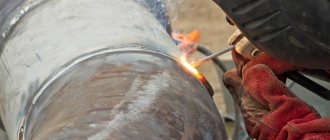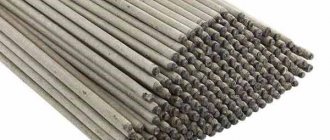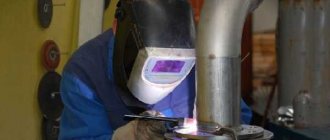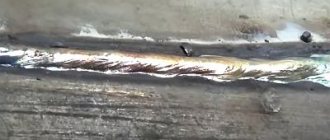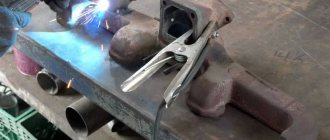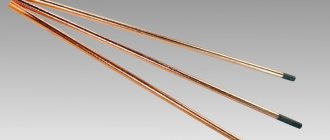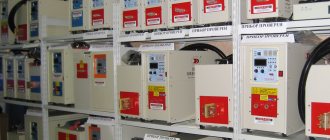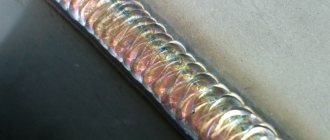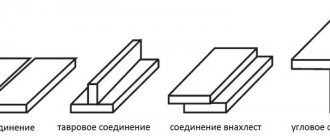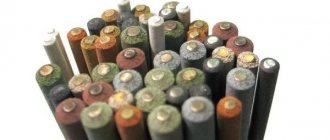Internal structure of a carbon electrode
These consumables often have a round cross-section, the diameter of which can be very different - from 5 to 25 mm. The length of the angles is also varied: from 25 to 300 mm. The longest types are used for welding in hard-to-reach places.
They are available in several shapes: round, semicircular, rectangular and hollow. Round and semicircular consumables are more often used - with them the welding seam meets all the requirements of technical standards.
Rectangular rods have their own tasks: they do an excellent job of repairing a wide variety of defects in steel surfaces. As for hollow consumables, their feature is the ability to form a U-shaped groove at the welding seam.
These electrodes are made from a rather complex mixture of coke and coal with various binder additives such as resin and special elements such as metal powder or shavings to strengthen the composition.
The production technology includes separate stages. First the mixture is formed, then the rods are formed from it. The third most important technological stage is the special heat treatment of the newly formed rods. The quality of consumables depends on the thermal stage of production.
Technological scheme for the production of carbon electrodes.
Sometimes two types of specialized rods are confused: carbon and graphite electrodes. There is no need to confuse them; these are different consumables both in their composition and in their scope of application.
There is another type of carbon electrodes - the so-called copper-plated ones. These are rods coated with copper plating. This makes them more durable while maintaining all other characteristics the same.
Safety requirements at work
Carbon-graphite electrodes require compliance with safety regulations:
- Wires must be de-energized before welding.
- It is necessary to use personal protective equipment - this can be special clothing and shoes, a mask, gloves.
- The area where work is being carried out must be cleared of flammable items.
- After completing welding work, insulate the twists. For this, electrical tape or heat-shrinkable tubing is used. They are put on the wires and heated with a hairdryer.
We recommend reading: The main features and nuances of using electrodes of the E50A type
By following these recommendations for welding copper wires, you can easily make a high-quality connection of elements.
Where are they used?
The main distinguishing feature of coal consumables is their versatility. The scope of application is varied: from cutting metals to surfacing and welding. The workpieces can be of any shape; the range of parts to be connected is much wider than that of electrodes with metal rods.
Almost any nature of metals is also allowed:
Steel
There can be alloys of any direction: stainless steel, alloys with low carbon content, low-alloy or higher-alloy grades, etc.
Cast iron and bronze
A carbon electrode is quite capable. There is a technical nuance here: its end needs to be sharpened at an angle of 65°.
Non-ferrous metals
Here you also need to sharpen the tip of the consumable, the angle in this case is 30°. Understanding and experienced welders prefer carbon models for welding finicky non-ferrous metals rather than traditional soldering. This is done due to the higher quality of the connection - its strength, first of all.
An additional advantage is the saving of time: welding with a carbon electrode requires much less than manipulating a soldering iron and solder with acid.
Carbon electrodes are more often used in industrial welding work on automatic equipment. A special feature is the rare AC connection. The fact is that the arc in this case is very unstable, and it is difficult to level it.
If the process takes place in industrial production, special high-caliber solenoids are used there to form a magnetic field for compensation. If welding is manual, solenoids cannot be used.
Partial stabilization of the arc can only be achieved with flux pastes applied along the seam or cut line.
The main power source is direct current with a direct polarity connection, when the positive pole is on the workpiece, and the negative pole is on the carbon rod. God knows how much current is needed to form an arc, for example, five centimeters long; 5 A is quite enough.
Welding with a carbon electrode.
If the polarity is connected incorrectly - in the reverse type, the electrode will immediately overheat entirely - along its entire length, as a result of which the carbon mass burns out and the quality of the welding process decreases.
A significant advantage of carbon consumables is the absence of a very unpleasant phenomenon in welding - sticking of the rod to the surface of the workpiece being welded. This occurs due to the low burnout rate of the consumable mass.
Sticking does not occur even if the welding technology is violated, which with other methods instantly leads to this problem. Therefore, carbon electrodes are a favorite method in the initial stages of learning to weld.
Once you have learned how to use these electrodes, you can move on to more advanced welding techniques to learn how to avoid electrode sticking.
Do-it-yourself welding with a graphite rod
In modern wire joining, carbon electrodes are increasingly being used to weld the ends of copper wires. This method replaces the outdated method of soldering copper strands. This does not require the use of solder or flux.
The task of welding is the same as with soldering - it is to ensure reliable and durable contact between two or even several wires, since this cannot be achieved with a conventional connection.
However, even such formed contact at an increased load prevents overheating of the welded cable cores.
Adjusting the current during welding
Current adjustment during wire welding occurs in the range from 30 to 120 amperes (most inverter welding machines operate in this range). In any case, you will have to empirically select the exact welding current , since:
- Each inverter has its own characteristics.
- Your network voltage may not correspond to 220 Volts.
- The chemical composition of copper wire strands may vary due to different manufacturers.
- In addition, it won’t hurt you to practice so that the work is completed as efficiently and quickly as possible.
You need to know the current values at which wires of different cross-sections are connected:
- when welding two wires with a diameter of 1.5 mm2, the inverter must be set to 70 amperes;
- three wires of the same cross-section are welded when the current mark on the inverter is from 81 to 91 amperes;
- the current strength for welding three wires with a diameter of 2.5 mm2 is required in the range from 81 to 101 amperes;
- four 2.5 square millimeter cores are welded with a current range set from 101 to 121 amperes.
How to weld core strands
To prevent possible melting of the wire insulation, a radiator made of metal must be attached to the base of the twist being welded. A clamp with a large contact area, which improves the heat transfer process, will help you remove heat from the twist. It is best for the radiator to be made of copper, since this metal has high heat transfer .
Before starting the process of welding the wire cores, it is necessary to carry out preparatory work, which includes the process of freeing the wires from insulation and sheathing. The length of the exposed wires should be approximately 100 millimeters, in this case the twist will be no more than 50 millimeters.
https://www..com/watch?v=H90wVcc7ZDE
When twisting the wires, it is necessary to ensure that they fit tightly together. In this case, the ends of the wires must be at the same level, otherwise during welding the core of one of the wires may end up outside the weld. If after welding one end of the core is longer than the others, it must be bitten off using side cutters.
Near the radiator you made, you need to attach a “ground or minus” clamp to the twist, then bring the electrode to the tip of the wires. Contact of the electrode with the conductors should not exceed two seconds. After contact is interrupted, a small spherical bead . The rest of the wire strands are also welded.
Required safety knowledge
When performing work, you must know and follow safety precautions:
- the wires on which copper conductors are welded must first be de-energized;
- mandatory use of personal protective equipment (workwear, gloves, masks, safety shoes);
- the place where you carry out welding work must be cleared of objects that may ignite;
- since there are more than two twists in the switchboard or box, do not rush and weld the next one, as you may get burned;
- It’s better to wait until the first twist you welded has cooled;
- After welding, the strands must be insulated. This can be done with heat shrink tubing or electrical tape. Heat shrink is applied to the wires and then heated using a hair dryer.
By following our recommendations for welding wire cores, the connection process will go without problems. We hope our article will be useful instructions for you.
- Fedor Ilyich Artyomov
Welding from a pencil
Miniature welding of metal conductors or small parts can be done using a regular pencil rod. A mini welding machine with a graphite rod can not only weld, but also cut metals of small thickness. How to apply it and for what, I think, you will decide for yourself.
Will need
- A step-down transformer.
- A simple pencil.
- Wires.
- Alligator clip.
Preparation
For a miniature welding machine you will need a transformer with an output voltage of 27 V. Its power is somewhere around 50-60 W. You can take any other transformer with similar characteristics, or use ready-made sources with adjustable voltage.
Simple pencil. It must be carefully cut along the gluing without damaging the inner rod.
We make improvised terminals. A crocodile for the general wire, and a homemade wire hook for the electrode.
We fix the graphite rod into the holder. We solder the wires to the transformer.
Metal welding
Before you start welding anything, take care of safety precautions. Be sure to use safety glasses and do not touch live parts.
You do all actions only at your own peril and risk, so be vigilant and careful. For welding, prepare a fire-resistant surface: a brick, a piece of stone or tile, etc. Let's get started. We will weld two copper wires.
We connect the common one to the wires being welded, and touch the electrode to the surface to be welded.
Initially, the arc does not heal, the lead smokes. This is normal for initial startup.
Do-it-yourself welding of copper wires with a graphite electrode: step-by-step instructions
To create reliable contact between several copper wires, the twisting method is used. With its help, industrial and household electrical networks are equipped.
Additionally, it is recommended to make a welded connection, which prevents the oxidation process between the cores and reduces the likelihood of the bundle unwinding.
Reliable welding of copper wires with graphite electrodes is carried out after studying the basic rules.
Copper wire welding technology
The connection must be made only after the final installation of electrical wiring in the room. For convenience, the minimum length of the mounting ends should be 10 cm. Additionally, the distance between the wires and the possibility of their placement in a closed junction box are taken into account.
Technology for welding copper wires using graphite electrodes:
- Cleaning cores from insulation - at least 5 cm.
- Trimming the ends of the wires to remove possible oxide.
- Twisting. The wires should fit snugly against each other. To do this, it is recommended to fix them at the bottom, where there is insulation. Twisting is done using pliers or similar tools.
- Welding. It is performed using graphite electrodes.
- The final insulation of the twist occurs after the cores have cooled. They are then placed in a protective box.
Carbon electrode welding
Carbon electrodes for welding are used less frequently than analog electrodes with a steel consumable rod. But in some situations they are simply irreplaceable.
In addition, using a carbon electrode, you can carry out a wide range of work: welding, cutting, melting. Plus, it processes almost all types of modern metals, from refractory and heavy to light and porous.
But first you need to understand what a carbon electrode is.
This is a rod based on coal (coke), plus several additives: resin is used as a binder, and metal powder is used as a strengthening element. The dimensions of the carbon electrode vary in diameter from 1.5 to 25 mm, and in length from 25 to 300 mm.
The production process is very simple: making a mixture of components, molding and drying. The question may arise why there is such a large variation in length. It's all about various problems that are solved by carbon electrodes.
For example, if the parts to be welded are located in an inconvenient place, then using a long rod solves the problem.
- 1 Types of carbon electrodes
- 2 Welding mode
- 3 Welding features
Types of carbon electrodes
Today, manufacturers offer five types, which differ from each other in cross-sectional shape.
- Round. Application is unlimited. Rod diameter – 3.2-19 mm.
- Round endless. They got their name for the lowest consumption, that is, these are the most economical welding electrodes in this category. Diameter – 8-25 mm. Usually a special machine is used for welding.
- Flat. The cross-section of the rods is rectangular (sometimes square) measuring 8-25 mm. Mainly used for sealing defects on the surfaces of steel castings.
- Semicircular. Cross section – 10-19 mm. Today these are the most popular electrodes, with the help of which you can solve any problems associated with cutting metal workpieces. When welding, the seam is formed into the required shape. They have no equal when it comes to edge shaping.
- Hollow. Rarely used. A distinctive feature is that they can be used to form a U-shaped groove. Rod diameter: 5-13 mm.
To increase the strength characteristics of consumables, their production technology began to use the method of sputtering copper powder onto the electrodes. The second method is electrolytic.
This is when both the rod itself and copper powder are placed in a bath of electrolytes. Here, under the influence of an electric field, copper settles on the plane of the consumable. That is, we have a subspecies called copper-coated carbon electrodes.
The type of separation is exactly the same as conventional carbon electrodes.
Welding mode
The carbon-type electrode belongs to the category of infusible elements. This is its main difference from the main category of metal welded rods. Therefore, when welding with its help, only direct current of straight polarity is used. That is, the minus is connected to the electrode, the plus to the metal workpiece.
It turns out that to weld metals using a carbon electrode, you will need a filler element. True, not always. For example, for flanging thin metal workpieces or for some options for welding corner joints.
This is both more profitable and convenient.
It should be added that the productivity of welding work when connecting sheets with a thickness of 1-3 mm using carbon electrodes without the use of filler material is several times higher than when welding with conventional non-carbon electrodes.
How to cook with carbon electrodes: features
First of all, you need to know and remember that they are non-fusible consumables. This means that during the process they act only as an electrical conductor, but do not take part in the formation of the weld pool, unlike their metal counterparts.
It's hard to believe, but even coal can boil. It does this at a temperature of 4200°C, but before boiling it melts – also at sky-high temperatures. During the welding work, the carbon rods heat up, but do not melt and, moreover, do not boil: the temperature of ordinary welding is simply childish.
It has already been mentioned here that with this method you can only use direct current of straight polarity without any options.
Cooking takes place using filler materials in two ways:
- from right to left, where in the general arrangement of parts the additive is always located in front;
- from left to right with an additive that follows the trace of the electrode.
The “left-to-right” method is considered more advanced, since it allows for higher welding speeds due to the efficient use of thermal energy. However, the “right-to-left” method is used more often - it is more traditional, it is better known.
If the type of work is special and, for example, involves beading metal workpieces with thin edges, squares can be used without additives. In this case, welding productivity will be significantly higher. Under one condition, however: the thickness of the joined sheets should not exceed 3 mm.
Classification of graphite electrodes
There are different brands of graphite products on the modern market, which differ in the type of material used for manufacturing. It is mostly graphite, but the quality is not the same.
Using different varieties, the following products are obtained:
- Graphite rods for welding.
- Colloidal graphite products.
- Impregnated – for “ladle-furnace” complexes.
- Special - for working with high-power units that are used in large industries.
In order for technological processes to take place in the required sequence, materials must be selected correctly. This takes into account what type of electrodes is suitable for the processes carried out in production.
We recommend reading Characteristics and operation of non-consumable electrodes
Graphite varieties are convenient to use in metallurgical plants. Such electrodes are capable of providing electrical energy input in processes that involve elevated temperatures.
Carbon electrodes in home workshops
Copper wire welding diagram.
To work with them in a makeshift manner, a traditional electric arc welding machine is quite suitable. One of the advantageous aspects is a very modest current strength for creating an electric arc due to low thermal conductivity: 3 - 5 A is enough.
An electric carbon arc can be extended to a length of up to 50 mm; it is very easy and comfortable to guide along the future seam due to the slow evaporation of the electrode during welding and the absence of a sticking effect.
Learn welding with carbon electrodes using examples of connecting wires, metal workpieces with thin edges, etc. – a wonderful opportunity to master all skills quickly and efficiently.
Important advice: this type of welding should only be done indoors. The fact is that the arc in such technologies can go out at the slightest breath of wind, not to mention gas flows, magnetic fields and other environmental factors.
It is best to sharpen the electrode at both ends: in this case, you will not need to waste extra time rearranging the consumables in the holder. In addition, the risk of consumable overheating during welding will be reduced.
And with sharpened ends, the holder can rotate 180° when one end overheats, so that the other end can continue working. This will also allow you to save on consumables.
Sometimes non-consumable carbon electrodes are used for welding copper busbars in transformers at substations. Copper wires are also welded, but this is mainly in small artisanal workshops.
The best option for filler materials is bronze alloy rods. They come with different diameters, which must be selected based on the thickness of the metal workpieces being connected, which is used in calculations using a special formula.
Another type of work in which squares are used is cutting metals.
Do-it-yourself welding of copper wires with a graphite electrode - instructions
Several copper wires can be connected in different ways.
Welding occupies a special place among them, since it is one of the best methods in terms of reliability. The connection obtained in this way is durable, has good electrical conductivity, meets the maximum safety requirements and lasts for many years.
For welding wires, a graphite electrode is used, which has several undeniable advantages.
Inverter welding machine
The inverter device has clear advantages over other devices:
- Small-sized parameters;
- Light weight;
- Adjustment of current parameters;
- The presence of a portable belt (it is convenient to carry out work on a stepladder, in a junction box);
- A stable arc that ignites at low currents;
- Quality of welded joints;
- Less energy consumption without changing the voltage of the household electrical network.
In addition, welding is carried out using transformer devices, devices, stations, devices made independently (if you have certain skills).
The ease of operation of the do-it-yourself electric arc spot welding machine has made it the most widespread. Main parameters of this equipment:
- Electric arc current;
- The mains voltage that forms an arc;
- Type of electric current (alternating, direct).
Welding technology
Welding work must be carried out using a protective mask, glasses, gloves, and special clothing. There is a possibility of getting burned by hot metal and “catching bunnies.”
Welding of copper wires at home with an inverter is carried out using graphite and carbon electrodes. You can replace the electrodes with the carbon rod of a used battery.
Approximate welding current range:
- 2 cores, cross section of each 1.5 mm² - 70 A;
- 3 cores, cross section of each 1.5 mm² – 80-90 A;
- 2-3 cores, cross-section 2.5 mm² – 80-100 A;
- 3-4 cores, cross-section 2.5 mm² – 100-120 A.
The copper used in the manufacture of electrical wires is of different composition and quality, which determines the welding mode used. Indicators of the optimally selected mode: the electrode does not stick to the welded area, the arc is stable. This combination can be maintained if you have experience in welding.
- The insulating sheath of the copper cable is removed (7-10 cm);
- Stranded wires are twisted;
- The twisted copper wires are trimmed to form an even cut. The remaining twist length is 5 cm;
- A copper clamping mechanism for removing excess heat is placed on the twist, and grounding (“ground”) is connected;
- The twist section is brought to the electrode;
- Welding work is carried out until a molten copper ball appears at the end of the wires, 1-2 seconds is enough;
- After welding of the copper strands stops so that the insulating material remains intact;
- The cooled ends of the wiring must be insulated (insulating tape, heat-shrink tubing).
In addition, it is necessary to promptly change the copper welding tip, which holds the electrode during welding. The main function is to supply electric current to the electrode rod.
Its condition determines the quality of the weld: the hole inside the tip should tightly hold the rod, but it quickly loses its properties during the welding process.
The copper welding tip wears out and most often requires replacement.
Electrodes for welding wires
The choice of the appropriate type of electrode determines the quality of the work done. It is necessary to select welding tools that optimally meet the parameters of the upcoming process. The general classification of these tools used in the welding process includes electrodes for:
- Alloy steel;
- High-alloy steel with non-standard parameters;
- Metal surfacing (applying a metal alloy or metal to the surface of an object by fusion welding);
- Non-ferrous metals;
- Structural steel;
- Cast iron.
The electrode coating defines the following typology:
- A – acid coating (oxide of iron, silicon, manganese);
- B – basic coating that allows welding with direct current of alternating polarity. Contains calcium carbonate, calcium fluoride;
- C – cellulose spraying creates gas protection during welding (flour, compounds of organic origin);
- R – rutile (rutile, organic, mineral components) provides a low percentage of metal splashing and gas protection.
Electrodes for welding wires:
- Coal – electrical coal;
- Graphite – crystalline carbon.
Popular brands
Among domestically produced electrodes, the most popular are the following:
- EG - graphitized, made from petroleum coke with the addition of coal tar pitch. Withstands operating current density up to 25 A/cm2. Equipped with nipples, it is used in electric furnaces for smelting ore and for welding metals in various combinations, for example, nichrome-copper welding.
- EGS - instead of an oil streamer, a needle streamer is used. Such products are used in electric furnaces in steel mills and metal refining plants.
- EGPs are additionally impregnated with pitch. It is used in electric arc cutting installations and foundries.
- EGSP - products based on needle coke, with enhanced impregnation with pitch. They are used to weld non-ferrous metals, as well as in melting furnaces for various purposes.
Graphite electrodes for welding
Composition – graphite, a carbon substance of dark gray color with a metallic sheen. The soft material makes it easy to cut elements. Graphite electrodes for welding show better results compared to carbon electrodes.
- The graphite electrode remains intact during the welding process;
- The cost is lower than coal;
- Suitable for inverter welding machines equipped with current regulation;
- The connection of wires by welding a graphite rod is durable and reliable;
- Welding with a graphite electrode ensures the metal's resistance to oxidation.
- Low consumption during welding due to the high melting point (four times higher than copper);
- When welding wires with a graphite electrode, it is possible to replace it with improvised graphite products (graphite rod, brushes of commutator motors, battery rods);
- The absence of copper plating of graphite substitutes is solved by using an alligator clip for the electrode instead of standard holders, and an alligator clip is also used to connect the mass.
- Do-it-yourself welding of wires in a junction box with these clamps is more convenient due to their smaller dimensions.
Production process
Both natural coal extracted from deposits and artificially produced graphite are used as raw materials for production . Various resins serve as binders. Production is divided into the following technological stages:
- extrusion of rod-shaped blanks at high temperature and pressure;
- final forming and cooling;
- thread cutting;
- copper plating
To produce products for a specific purpose, small amounts of metal additives are added to the material.
Carbon electrodes for welding copper wires
- The melting point is 3800⁰ C, the boiling point is 4200⁰ C, so the melting process is invisible, evaporation is recorded;
- Welding work with a carbon electrode is carried out with straight polarity;
- The welding process with a carbon electrode is accompanied by the influence of external factors (wind, gas flow);
- The efficiency of the welding arc is lower;
- Scope of application: welding work on thin sheet metal, non-ferrous alloys, correction of defects in metal casting;
- Methods of welding work: without filler material, feeding the filler into the arc, laying the filler metal on the seam;
- The most common method is melting the edge of the elements being welded (non-additive);
- The magnitude of the welding current is determined by the thickness of the metal and the type of connection;
- When warming up, carbon electrodes for welding copper wires are quickly consumed;
- Creates a high-temperature welding arc (even at low current).
Recommendations
Useful tips that will help you weld wires with your own hands efficiently:
- Do-it-yourself use of non-copper-plated graphite rods for copper wires in welding work. Burning out the corner of the electrode will lead to a decrease in resistance and prolonged contact, which will deteriorate the quality of the electrical wiring connection.
- The formation of the required shape of the copper solder ball is facilitated by the preliminary preparation of the graphite rod: a recess is made inside the end.
- Using an alternative to factory rods (waste batteries, trolleybus current collectors, etc.).
- The use of a protective mask, glasses, gloves, and special clothing is mandatory.
- Welding of twists is checked by applying maximum voltage to the network. Lack of heating is an indicator of a high-quality connection.
- Soldering or welding copper wires is better than simple twisting, terminal connections, and clamps.
- The correct choice of electrode rod and welding mode determines the quality of the result and the reliability of the weld.
- Using an inverter machine is advisable in everyday life, with frequent welding work for wires on your own.
Read also: Photos of welding inverter boards
Before carrying out work on connecting the cores of electrical cables, it is necessary to determine how to do it, what is best to choose for this particular situation. The correct choice greatly contributes to the successful result of the work done: the quality of the connection, the flow of current, the reliability of electrical wiring during peak load on the network.
You should not trust twisting electrical wires as a connection method. This is a rather unreliable option. Terminal and crimping mechanisms increase reliability, but are inferior in quality to soldering and welded connections.
In order to connect two wires, several techniques are used. This can be twisting, soldering or welding of various wires. The last technique is one of the most successful and frequently used. It helps to achieve long service life of electrical wiring.
It is mainly made from a copper composition rather than aluminum, which is not suitable for these purposes. Welding occurs using direct and alternating current, at a voltage of 12-36 V. Directly for the process, we recommend using an inverter welding machine.
Copper wire welding technology
There is one technique that always leads the welder to the best result. As mentioned earlier, the best device for welding is an inverter. Then they take hold of the wire. It is freed from insulation and excess shell and twisted. When cutting wires, the ends should remain the same length and at the same level, and the twist should be at least 50 mm in length.
Next, a heat repellent copper clamp is installed and the welding machine is connected. The charcoal pencil (or rather its end) is brought closer to the finished twist. When welding, the pencil must be clamped in the holder.
Welding of strands is considered complete once a small molten ball of copper has formed. In order for the insulation to remain intact, you must not overdo it, but devote no more than 1-2 seconds to each twist. When welding of copper wires is stopped, ordinary electrical tape or a similar version is used to insulate the frozen part.
Step by step process
Let's describe the whole process step by step:
- Remove the insulation on the wires;
- We make twists;
- Add mass;
- Turn on the welding inverter;
- We bring the electrode to the twist until an arc forms;
- Contact duration is 1-2 seconds;
- We proceed to the next twist (if there is one), after the finished one has cooled;
- We insulate using heat-shrinkable tubing or electrical tape.
The device should be selected with the ability to adjust the current, the strength of which should be 30-90 amperes. The electrode used is carbon containing copper.
Production Standards
Requirements for production technology and quality are formulated in GOST 4426-62 . It describes the chemical composition of the product, manufacturing methods, their design and the following typical cross-sectional shapes:

